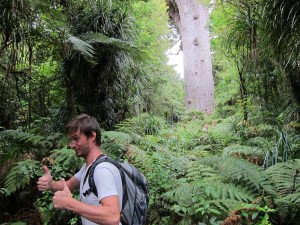The western side of Northland.
The Hokianga

When I left Kaitaia, it was a grey, cloudy day, doing that misty Far North thing I’d come to expect. I avoided State Highway One (so mainstream) and headed south on a road that went from Ahipara to Kohukohu, via the pleasant valley town of Broadwood.
Kohukohu was on the itinerary because that’s where my gran was born and where she met my grandfather, a cool dude rocking into town on his motorcycle, with stories of Chicago. Kohukohu is now a chilled out little settlement on the shores of the Hokianga. There’s nothing to do there, which is why people go there.

Rawene is another sweet little harbourside town. As the guide at the historic Clendon House said, living in the Hokianga is like living in the 1950s, except they’ve got the internet. Even the local diary still has “MILK BAR” written on its window, as if a car full of those newfangled teen-agers is going to pull up and slurp milkshakes while listening to Johnny Devlin.
Towards the west coast is the town of Opononi, best known for being the home of Opo the happy/gay/friendly dolpin. Opo’s fame only lasted for nine months before her tragic death in March 1956, but that summer of ’55/’56 must have been the most golden summer ever for Opononi – a celebrity dolphin that drew thousands of tourists to the area.
Opo was buried in front of the War Memorial Hall. And even though it happened almost 60 years ago, the village is still full of dolphin icons. Opononi’s identity is very much “dolphin woz here in ’55”.
The Kauri Coast

Oh, actually – there was the Waimamaku Wild West Festival. Wamamaki is a tiny settlement just south of Opononi and I was passing through on the day of their annual Wild West Festival. Must of the festival actually seemed to be happening on State Highway 12 itself (there was no way for traffic to bypass), so I was driving along at about 10km/h while ladies did linedancing just centimetres away from my window and crowds cheered on the other side. Horrifyingly, there were children running around on the road. And even though I wasn’t going fast, it’s still really unpleasant to have to slam on the brakes to avoid hitting a hyperactive 10-year-old. But these incidents were accompanied by a man on a loudhailer yelled at the kids to bloody stop running around, ya mongrels, which probably counts as effective crowd control in the wild west.
Further along State Highway 12 is the star attraction of the kauri coast – Tane Mahutu aka Giant Kauri Tree. It’s a short walk from the main road, and suddenly there it is – this giant tree. It was like Cape Reinga – I was expecting it to be a deeply spiritual experience, but it was just a big tree. I prefer the Tane Mahuta that I imagined before I got there, with naked hippies leaping over the fence to hump the trunk. It’s less thrilling when the reality is busloads of European tourists all lining up to have their photo taken in front of the really big tree in New Zealand.
Dargaville

Dargaville was a welcome relief, which surprised me. It’s quite a pleasant riverside town, though it does have a really hardcore bogan vibe to it. I would not be surprised if it had the highest goatee ratio per head of popular.
Dargaville Museum had three highlights. The first was the introductory video about swamp kauri. It looked homemade and involved a couple of codgers talking about the “tsunamu” that probably made all the trees falls over. The video concluded with an artisan turning a gnarled log of swamp kauri into a highly varnished, shiny orange gnarled log coffee table. The second highlight was the hall commemorating the gumdiggers of the region, including a the spades of mostly Dalmatian gumdiggers. The hall was dedicated in memory to one of the locals who’d been fundamental in getting it organised, borrowing Christopher Wren’s memorial at St Paul’s Cathedral: “Reader, if you seek his monument – look around you.”

The last stop on the Kauri Coast was the Kauri Museum in Matakohe. I don’t even know where Matakohe is.
If you like kauri wood and kauri gum and the history or kauri gum digging and milling and swamp kauri, then the Kauri Museum will be a real treat for you. But by this stage, I was sick of all things Kauri. It was a novelty when I saw some stuff about it in the Kataia museum, but when that’s all there is, it gets tiresome fast.

I found myself wandering around the different halls, totally numb to the apparent allure of kauri. The highlight was a giant, kitschy table, originally made by Lion for their boardroom, later donated to the Governor General, and now taking pride of place in the Kauri Museum. No wonder the GG didn’t want it – it had a crack in it.
I started to fantasise about being in a room with all white walls. No kauri. No glowing orange gum. No rich orange wood panels.
So obviously by this stage I needed to go home. By the time I reached West Auckland, I was thrilled by the novelty of roads with things – buildings, people, other cars. The further south I drove, the cooler the weather came. Back into the Waikato where the land is criss-crossed with roads and villages, back along a boring-as road where nothing happens.